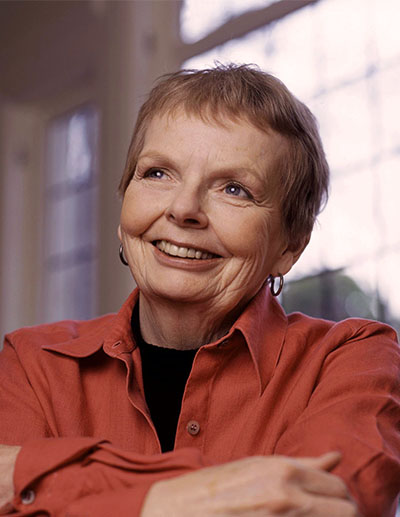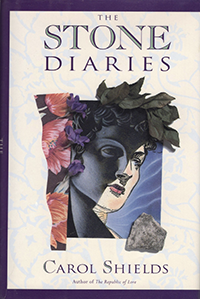Carol Shields was born in Oak Park, Illinois, in 1935, and grew up in a house at 700 S. Kenilworth Avenue. “I attended Nathaniel Hawthorne School and Ralph Waldo Emerson School,” Shields said in a May 23, 1988 interview with the Academy of Achievement. “I knew the schools were named after writers — both were male writers, both were dead. I wondered if there were any female writers, live female writers. Perhaps it was then that I started to question the dominance of males in our lives.”
Shields was the youngest of three children. Her mother worked as a school teacher, her father in a downtown office. In that same interview, Shields said she wrote as a child, but didn’t imagine that as her calling. “I felt like wanting to be a movie star,” she said.
During those childhood and adolescent years in Oak Park, Shields did write. “I did the class poem and the class play,” she said. “There’s always one of those girls. Worked on the literary magazine.”
But more so she read.
She has chronicled her intense relationship with the Oak Park Public Library, writing, “All the Saturdays of my childhood were spent at story hours, and I remember one terrible, cold and stormy Saturday when only four or five of us turned up. Instead of going down to the library basement where there was a tiny theatre, we sat around one of the little tables. I looked into the eyes of those other children at the table, ardor clearly stamped on their faces, with fanaticism too. We were different. Other children loved these Saturday mornings, too, but we, for some reason, needed it.”
Shields commenced with Oak Park-River Forest High School’s Class of 1953, 36 years after Ernest Hemingway had graduated from the same school. Her graduating class, more than 700 students, was all white, a reflection of the conservative and parochial values, as well as the relative affluence, that characterized her hometown during those years. It was, according to Shields, this vague itch to experience a broader world that led her to seek out stories from an early age, and also, like Hemingway before her, to leave.
She obtained an undergraduate degree in English, with a minor in history, at Hanover College in Hanover, Indiana. Then she moved to Canada in 1957 after marrying a Canadian, Donald Shields, in her childhood home. Shields stopped writing early in her marriage, but Donald encouraged her to revive her pursuit after the birth of their second child. Even as she cared for young children, Shields attended a writing course at the University of Toronto, where she wrote short stories and poems, including those collected in Others (1972) and Intersect (1974). At the University of Ottawa, where Shields pursued an MA in Canadian Literature starting in 1969, she completed a thesis on Susanna Moodie that would be the basis for her first novel, Small Ceremonies. That novel, published in 1976, focused on biographer Judith Gill, who desires to write fiction. At 40 years old, the devoted mother of five children had herself launched a literary career in earnest; she also established her gift for making the ordinary into the riveting.
Another novel, The Box Garden, came out a year later, and then her third novel, Happenstance, followed in 1980. Shields wrote steadily—novels, plays, poetry, essays, criticism, short fiction and biography, receiving numerous recognitions and awards, including the Pulitzer Prize for Fiction.
“Carol Shields wanted to write away the invisibility of women’s lives,” said Susan Swan, author and co-founder of the Carol Shields Prize for Fiction. “So she wrote beautifully crafted fiction, plays, poetry, essays and biography about women. She also edited anthologies like Dropped Threads which featured essays by women from all walks of life talking about things they wished they’d been told.”
High praise from authors such as Alice Munro and Margaret Atwood accompanied Shields’ publications, even early on. Her reputation grew to more of an international status after the publication of her novel, Mary Swann (1987). Even as Shields became firmly ensconced as one of the most important literary figures of her generation, she was frequently called a Canadian writer. But her work often crossed those boundaries. Unlike Hemingway, whose body of published work included just one obvious Chicago setting, Shields used her hometown and the larger city on its border in several novels, namely Mary Swann, Larry’s Party, and the unfinished Segue. The short story “Dolls, Dolls, Dolls,” recalled the murder of a ten-year-old girl in Chicago and was, according to Shields, her only autobiographical piece of writing.
In 1995, Shields received the Tradition of Excellence Award in Literature from her alma mater, Oak Park-River Forest High School.
In addition to her career as an author, Carol Shields worked as an academic editor; taught at the University of Ottawa (where she earned a Master of Arts degree), the University of British Columbia, and the University of Manitoba; and served as Chancellor of the University of Winnipeg. She received fifteen honorary degrees.
“There are so many qualities to value and appreciate in Carol Shields’ work that many different prize juries have honored it and book-length critical evaluations have been written about it,” said Anne Collins, Carol’s publisher and editor in Canada. “Her sentences are so fine they still feel freshly minted. But what makes me put her in the category of novelists whose work will reward readers even hundreds of years from now is something only the greatest of writers are able to do. Her fiction not only has the power to move a reader immediately—to make you feel every nuance of every bind her characters find themselves in, every joy, every sorrow—but also to give you just that little necessary distance, somehow, a vantage point that launches you into larger reflection on how we humans live. Our vanities, the ephemerality of our lives—how fleeting, and therefore precious, our time is. Carol had a wicked eye for human foibles, and the stories we tell ourselves, and for what happens when life strips those stories away, but also such generosity. I felt this all again, and keenly, as I was recently rereading the published fragment of her last, unfinished novel, Segue, set in her birthplace of Chicago, a place that was clearly much on her mind as she approached the end of her own life. Even in twenty short pages, her characters are fully fleshed, setting off cascades of speculation and empathy in the reader—exactly what we look for in fiction, and what only a novelist with Carol’s gifts can bring us.”
The Carol Shields Prize for Fiction—co-founded by Swan, editor Janice Zawerbny, and arts activist Don Oravec—was announced in 2020. The new English-language literary award celebrates creativity and excellence in fiction by women writers in the United States and Canada. The inaugural Prize will be awarded on May 4, 2023. Four finalists will each receive $12,500 US, with the winning author to be awarded the sizable $150,000 US purse. The Prize is managed by the Carol Shields Prize Foundation, which encourages participation of women in the literary arts. The Foundation provides scholarships, bursaries, and other forms of financial assistance to women writers to support the production of high-quality literary works.
“In her writing and her life [Carol Shields] stands for the mission of our prize: to support and honor the voices of women writers,” said Swan. “As soon as we named the prize after her, the pushback we’d been experiencing stopped. No one would say a word against her. She was a beloved author and activist widely admired for her writing.”
Anne Giardini, author and daughter of Shields, contributed to this profile.
read less









